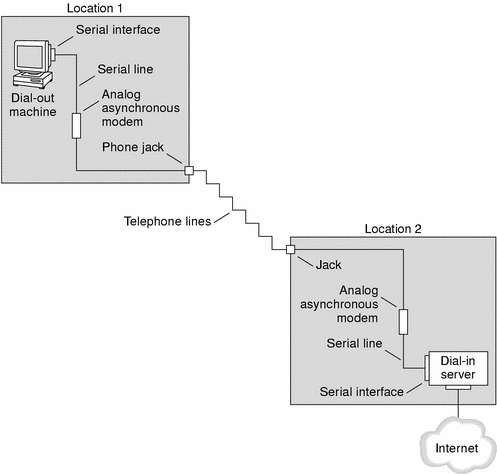Dial-up PPP Overview
The most commonly used PPP configuration is the dial-up link. In a dial-up link, the local peer dials up the remote peer to establish the connection and run PPP. In the dial-up process, the local peer calls the remote peer's telephone number to initiate the link.
A common dial-up scenario includes a computer in a user's home that calls a peer at an ISP, configured to receive incoming calls. Another dial-up scenario is a corporate site where a local machine in one building uses a PPP link to transmit data to a peer in another building.
In this guide, the local peer that initiates the dial-up connection is referred to as the dial-out machine. The peer that receives the incoming call is referred to as the dial-in server, although this machine is simply the target peer of the dial-out machine.
PPP is not a client-server protocol. Some PPP documents use the terms “client” and “server” to refer to telephone call establishment. A dial-in server is not a true server like a file server or name server. Dial-in server is a widely used PPP term because dial-in machines often “serve” network accessibility to more than one dial-out machine. Nevertheless, the dial-in server is simply the target peer of the dial-out machine.
Parts of the Dial-up PPP Link
Figure 29–2 Basic Analog Dial-up PPP Link

The configuration for the dial-out (Location 1) side of the link is composed of the following elements:
-
Dial-out machine, typically a personal computer or workstation in an individual's home.
-
Serial interface on the dial-out machine. /dev/cua/a or /dev/cua/b is the standard serial interface for outgoing calls on machines that run Solaris software.
-
Asynchronous modem or ISDN terminal adapter (TA) connected to a telephone jack.
-
Telephone lines and services of a telephone company.
-
Telephone jack or similar connector, connected to the telephone network
-
Asynchronous modem or ISDN TA
-
Serial interface on the dial-in server, either ttya or ttyb for incoming calls
-
Dial-in server, which is connected to a network, such as a corporate intranet, or, in the instance of an ISP, the global Internet
Using ISDN Terminal Adapters With a Dial-out Machine
External ISDN TAs have faster speeds than modems, but you configure them in basically the same way. The major difference in configuring an ISDN TA is in the chat script, which requires commands specific to the TA's manufacturer. Refer to Chat Script for External ISDN TA for information on chat scripts for ISDN TAs.
What Happens During Dial-up Communications
PPP configuration files on both the dial-out and dial-in peers contain instructions for setting up the link. The following process occurs as the dial-up link is initiated:
-
User or process on the dial-out machine runs the pppd command to start the link.
-
Dial-out machine reads its PPP configuration files and sends instructions over the serial line to its modem, including the phone number of the dial-in server.
-
Modem dials the phone number and establishes a telephone connection with the modem on the dial-in server.
If necessary, the dial-out machine sends commands to the dial-in server to invoke PPP on the server.
-
Modem attached to the dial-in server begins link negotiation with the modem on the dial-out machine.
The series of text strings that the dial-out machine sends to the modem and dial-in server are contained in a file called a chat script.
-
When modem-to-modem negotiation completes, the modem on the dial-out machine reports “CONNECT.”
-
PPP on both peers enters Establish phase, where Link Control Protocol (LCP) negotiates basic link parameters and the use of authentication.
-
If necessary, the peers authenticate each other.
-
PPP's Network Control Protocols (NCPs) negotiate the use of network protocols, such as IPv4 or IPv6.
- © 2010, Oracle Corporation and/or its affiliates
